The Samsung Galaxy S6 and S6 edge Review
by Joshua Ho on April 17, 2015 9:00 AM EST- Posted in
- Smartphones
- Samsung
- Mobile
- Galaxy S6
- Galaxy S6 Edge
Display
As we briefly discussed in our look at the specifications, the Galaxy S6 line introduces a newer generation of AMOLED displays, which is said to increase maximum luminance to 600 nits. Samsung claims that this was achieved with the use of new materials, which is likely necessary in order to sustain power efficiency improvements. It doesn't seem that AMOLED is uniquely suited to high resolution, but rather that Samsung Display Corp. is managing to dramatically improve how they make AMOLED displays with every year that offset power consumption increases from higher resolution displays.
To find out how Samsung did, we use SpectraCal's CalMAN 5 Ultimate, in addition to X-Rite's i1Pro2 Basic to characterize displays as accurately as possible.
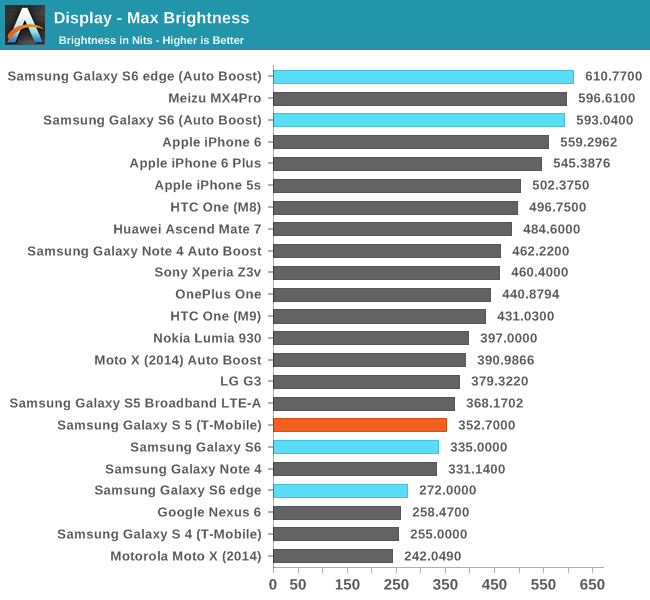
From the results Samsung's claims of a 600 nit display are valid in this case, which is a 100% APL white display. It's important to note that achieving this requires the use of auto-brightness, and that manual brightness is limited to a much lower brightness to reduce power usage, here the S6 sees similar maximum brightness as the S5. The S6 edge disappointingly only achieves 272 nits in this mode, a rather low value. I saw color balance shift dramatically in auto-boost mode, which suggests that this operating mode is likely less efficient than manual brightness. As an explanation, we've seen that colors are controlled in AMOLED by voltage while brightness is controlled by PWM (pulse width modulation). As with most recent AMOLED displays, there's no DC bias to the pixels so the contrast really is infinite instead of just a very large number when displaying black.
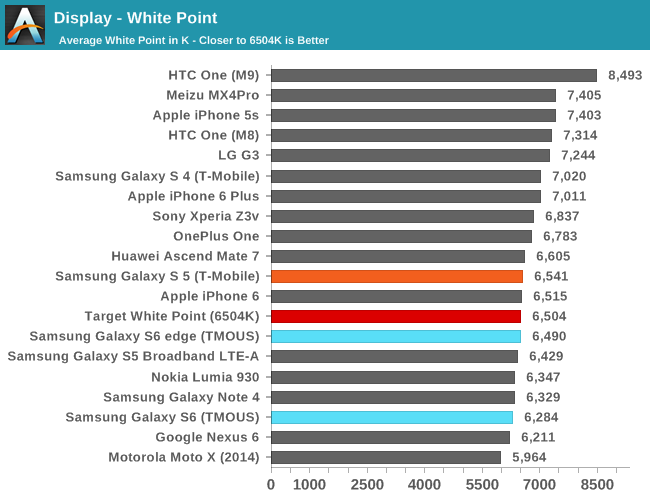

Moving on to grayscale, we can see that Samsung has done a pretty good job of controlling the white point and gamma across the saturation sweep, even if green is slightly dominant in both displays. We can also see that there is variation across displays as the S6 edge is closer to neutral while the S6 sample tends a bit warmer.
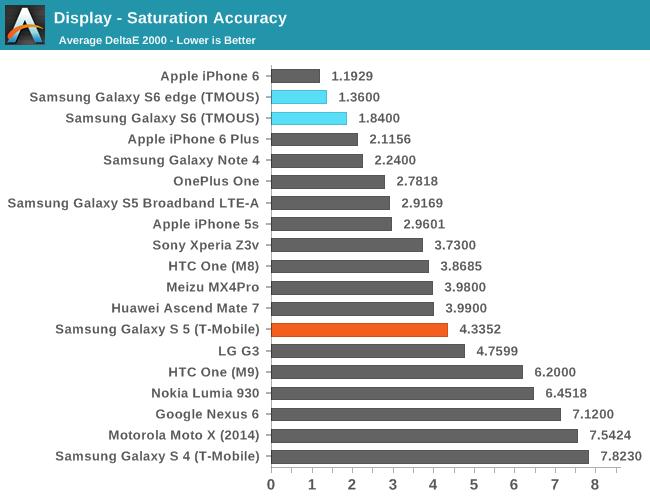
In the saturation sweep, both displays do an incredible job. I really don't have anything else to say here, because there's really no way to improve on the level of calibration Samsung has done on this display. Unless Samsung calibrates every single display in production, which is wildly impractical and effectively impossible to do, this is as good as it gets for a mass-produced device. Improving past this point will also be incredibly difficult to perceive, which means there's no real reason to go any further.
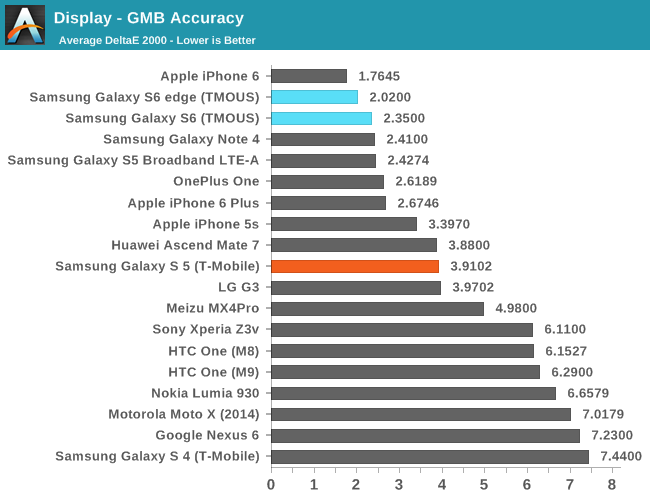
In the Gretag MacBeth ColorChecker, we can get an idea for overall color accuracy, which paints a picture similar to the saturation test. The only real problem I've noticed with these displays are the viewing angles, which can produce color shifting when the display is tilted. This is a bit of an issue on the edge variant as I can see that the edges of the display appear somewhat green when viewed head on, but otherwise there are no real issues to be seen here.
Overall, from a color standpoint it’s looking like Samsung has made one of the best displays available on the market today. Color accuracy is at the point where it’s pretty safe to say that the calibration doesn’t have clear color errors, and the peak brightness of the display is incredibly high. The 1440p resolution helps to compensate for the PenTile subpixel layout so in practice it’s effectively impossible to make out any pixels or the subpixel pattern. The contrast remains infinite as with most modern AMOLED displays, and overall it’s really hard to find any issue with the Galaxy S6’s display at first.
However while the S6 edge seems to be without any issues, the S6 does have some odd display issues that can be seen in direct sunlight as seen in the photo above. To be clear about this the photo above is a simple white screen, which should make the image completely homogeneous but instead there are two visible vertical lines and another jagged horizontal line that appear across the display. Inspection under a light microscope doesn’t really reveal what’s causing this, but the defect is quite visible in practice as seen in the photo above. I suspect that defects are rare, and in any condition other than direct sunlight I can’t see this visual problem.
While trying to see what this kind of defect looked like under a microscope, I also went ahead and took some photos of the subpixel pattern. As far as I can tell, it looks like the green subpixels have a bit more variance than what we’re used to as they tend towards oblong shapes rather than circles, which is likely due to the much tighter pixel density. It seems that this variance may cause some color shifting in certain units, which seems to remain a potential problem with Samsung's AMOLED displays. The pixel fill factor still remains surprisingly low when compared to LCDs, which usually have much higher active area. Due to the subpixel arrangement and some other differences in the display design, color shifting also remains higher than one would expect from LCD displays that are found in phones like the iPhone 6.
The final test that I managed to run on the Galaxy S6 is the brightness vs APL test, which shows the advantage of AMOLED’s emissive nature as it can dynamically increase brightness if the entire display isn’t showing a white screen. As a result, this means that in low APL scenarios like dark movie scenes and app themes it’s possible to see a maximum brightness closer to 700 nits or higher. However, in practice the display’s practical brightness is closer to 600 nits.
Overall, the display is still one of the best on the market, but I would be a bit concerned about fill factor for VR applications as that was a problem on the Note 4. Issues like purple smearing have been resolved, but there are still some problems with the display such as color shifting with changes to viewing angles and some variability in display quality from unit to unit. With this generation I suspect Samsung is either meeting or exceeding the best LCDs in quality, and with the next generation of AMOLED it’s likely that high end smartphones will have to migrate to AMOLED to remain competitive.



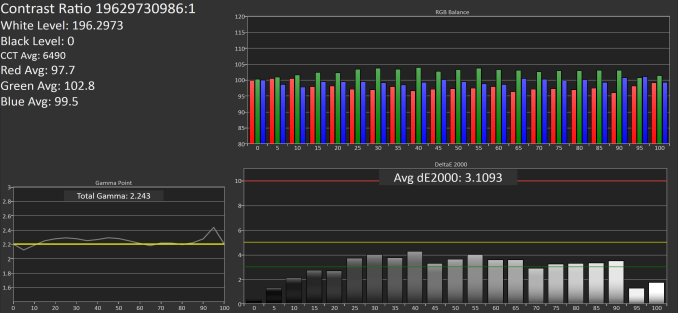
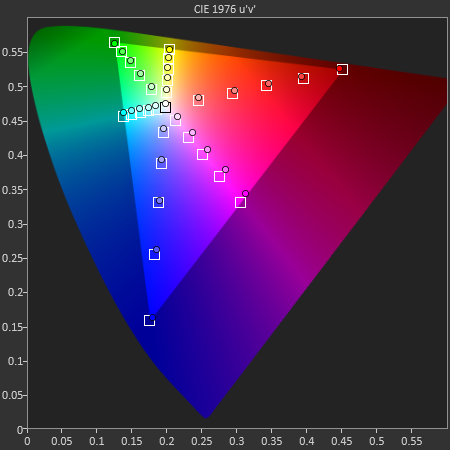
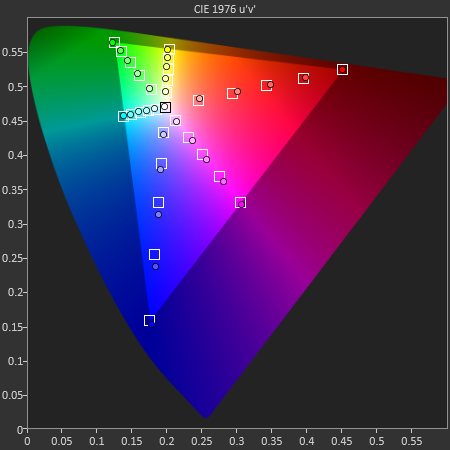
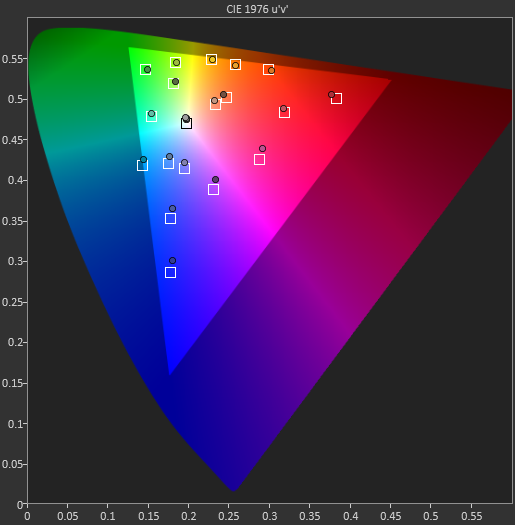

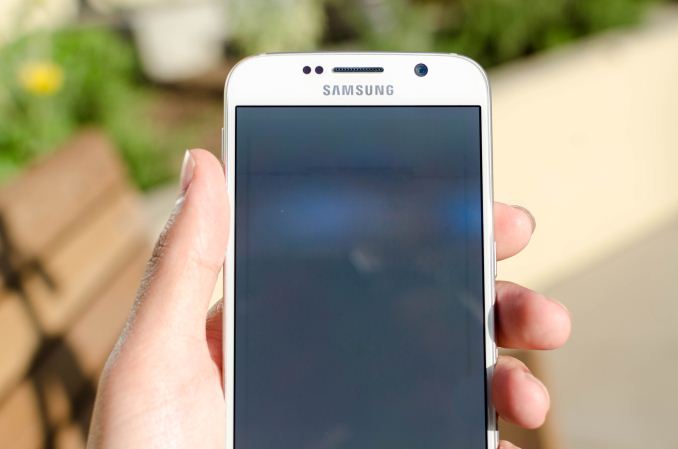
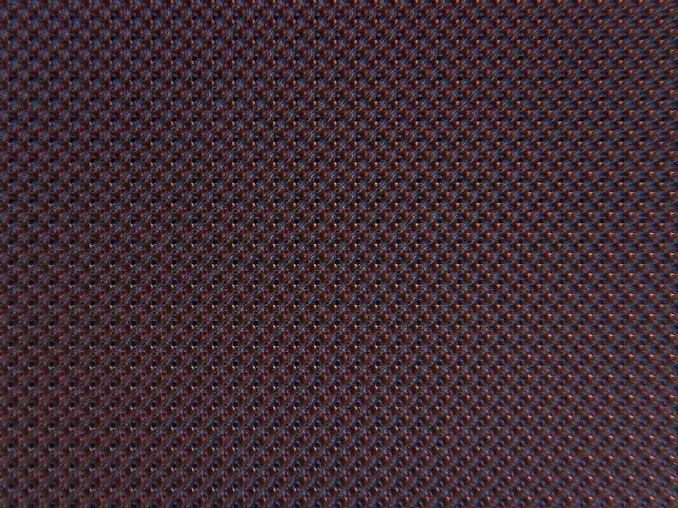
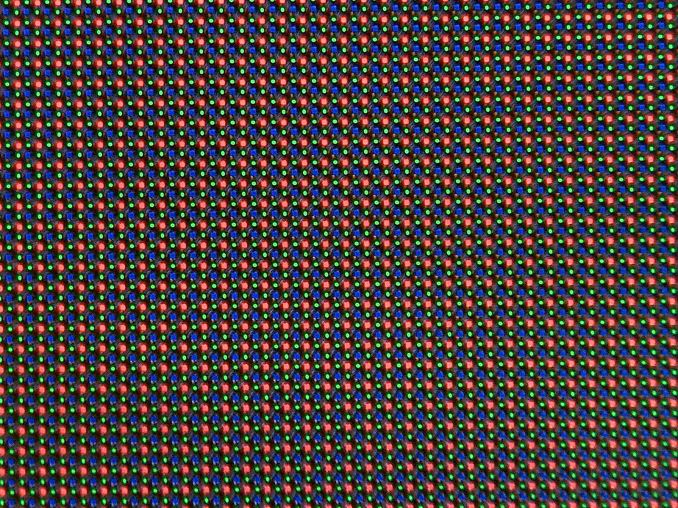
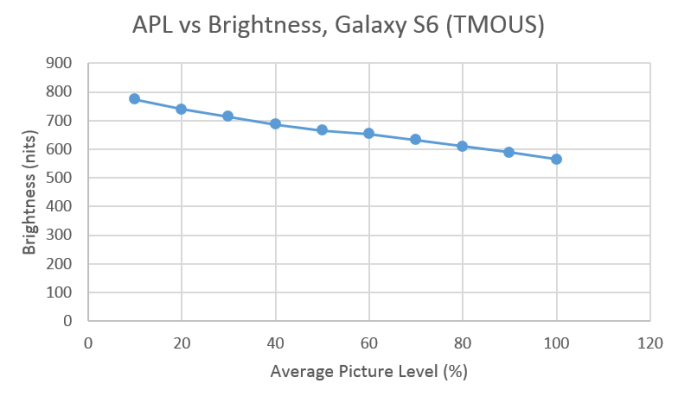








306 Comments
View All Comments
Margalus - Friday, April 17, 2015 - link
It's not "without" a warrant. Read what the op said and what I responded to. A judge legally subpoenaed the information and that person wants to hide it from the courts. Big difference from just grabbing your phone and getting the information without a subpoena.Buk Lau - Saturday, April 18, 2015 - link
Warrants and subpoenas are both writs, which the court issues with legally justified reasons. In essence they are the same thing, so unless you are actually engaged in illegal activities I see no reason to be scared that your fingerprint can get subpoenaed LOLFlushedBubblyJock - Friday, April 24, 2015 - link
you mean the court issues with any lies and excuses they so desire, including those far outside the spirit and letter of the lawthat's current reality sheepy
akdj - Sunday, May 31, 2015 - link
That's paranoid backwoods Idaho shit bub. Nothing to do with 'reality'LordConrad - Friday, April 17, 2015 - link
Lawyers and Doctors are examples of people with legal and sensitive information. Also corporations worried about corporate espionage. That's just off the top of my head, I'm guessing you didn't think before responding.Also, just because the average person has nothing to hide does not mean they should lose their right to protect their data.
Margalus - Friday, April 17, 2015 - link
I thought before responding. The key thing here is that a court issues a legal subpoena for the information. You are talking about hiding information from a judge that has legally subpoenaed the information. Unless what you are doing is illegal, there is no need to have to hide it from the court that legally subpoena's the information. And in fact you would be breaking more laws by trying to subvert a legal subpoenaNow if you are a child rapist that records what you do on your phone, I could understand about being worried about "legal" subpoenas.
LordConrad - Saturday, April 18, 2015 - link
You aren't subverting anything if you use a pattern or password lock, because knowledge CAN'T be subpoenaed as it's protected by the fifth amendment. Also, how many times have police agencies obtained information without due process? Good attorneys can usually get such information thrown out, but not always.akdj - Sunday, May 31, 2015 - link
You're in luck. In order TO USE the fingerprint system, one must 'choose a password, pattern ...' (Possibly tgird choice, can't remember not gonna look) as a backup. So you're both gonna be alright. Just quit with the paranoia. Judges, lawyers and doctors don't have things to hide in their cell phones, anymore than a CEO of a corporation or Jony Ive that a court's going to subpoena its contents without damn good reason.Let's see how far ol Tom Brady wants to 'appeal' this decision. After talking to Goddell, if the suspension is upheld, Tom won't be able to hide, dispose of or erase the contents of his cell phone, iPad or computer ...however he communicated with 'the deflator' -- the court can absolutely then subpoena his phone, as well as the ball boys' phones. They should be worried. If you should, maybe you should check yourself.
It's like the paranoia of cloud storage, using Google or allowing 'Pop Ups'. It's irrelevant what you're doing to 'hide'. You can't. If you're online, everything you do is forever embedded somewhere, in some server, and won't go away.
Like BubblyJack below me (jocks don't spend all day bagging on Apple when no one else has mentioned them) -- digital paranoia is silly, unless you're doing something illegal and IMHO, if you are and these tools catch you, AWESOME, more power to the 'tools, capturing digital thieves, identity thieves and phishing antagonists, child porn traders and drug sales sites like the Silk World Take down recently, torrenting sites stealing music and TV or movies --- they're all bad, they all suck, and they should be exsposed
** I'm in no way endorsing government censorship or web oversite, including the ability to gamble, watch porn ( of age ) --- even buy weird, niché stuff, but breaking the law is braking the law, and we've got internationally recognized 'law' and morales that I'm absolutely for 'governing' online. It would really suck if the 'net was somehow broken because of the 1%'ers, and not holding back your information can't 'teach' systems like Google more than they can hurt us when it comes down to it **
akdj - Sunday, May 31, 2015 - link
Last line was supposed to be allowing our information to Google CAN teach the 'systems' and in turn, Us more about ourselves. Interests. Health. Shopping deals and aggregation of our own data, pictures, media collections and management. If we allow it to, we're just a number in a pot of hundreds of millions.FlushedBubblyJock - Friday, April 24, 2015 - link
lordconrad, the sheep have been trained, expect no enlightenment, no western standards, and no cluethus we have the current situation, all the data is mined and bluffdale is packed to the gills
the retards won't believe no matter how many times they are informed and it is proven to them, and their pat answer is : what does it matter anyway!!??!! ( only a criminal would care )
so I'm not certain how eggheads have become glorious useful idiots, other than the wool is so thick there's no meat on them bones, and the shrunken brain has crumbled to coddled dust